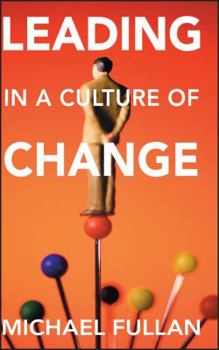Leading in a Culture of Change
Select Format
Select Condition 
Book Overview
The new edition of the best-selling guide for powerful, morally-grounded change leadership in any organization. Change is an inevitable, essential part of the modern world. Change prevents stagnation,... This description may be from another edition of this product.
Format:Paperback
Language:English
ISBN:0787987662
ISBN13:9780787987664
Release Date:January 2001
Publisher:Jossey-Bass
Length:166 Pages
Weight:0.45 lbs.
Dimensions:0.5" x 6.0" x 9.0"
Customer Reviews
5 ratings
Very well summarized review of change process
Published by Thriftbooks.com User , 14 years ago
Fullan does a complete job of providing tools for change leaders. This book provides the conversation starters for any leadership team wanting to make their organization better by leading it through sustained change.
Helpful
Published by Thriftbooks.com User , 16 years ago
Leading in a culture of Change was very helpful. It showed a great comparison between leadership in the business world and leadership in the world of education. There were many ideas to ponder and consider implementing.
Great Read
Published by Thriftbooks.com User , 16 years ago
Fullan's book is a good, straight to the point read. It is a very insightful, easy to follow guide on leadeship.
A Framework for Leadership in Today?s World
Published by Thriftbooks.com User , 20 years ago
During a time of rapid change and so-called leadership gurus, Michael Fullan draws from a wealth of research, case study scenarios, and theory to present an interconnected framework of five capacities for leadership which are relevant in today's world. These five components include moral purpose, understanding change, relationship building, knowledge creation and sharing, and coherence making. When effective leaders possess characteristics of energy-enthusiasm-hopefulness and practice the five components, one can expect the outcome that "more good things happen" and "fewer bad things happen."The five capacities of leadership are interrelated. Moral purpose, both a leadership quality and a natural result of the other four leadership components, involves "doing the right thing" for your organization and the world while contending with the diverse interests of competing groups. Fullan analyzes the change models of Kotter (1996); Beer, Eisenstat, and Spector (1990); and Hamel (2000); and concludes that they all contain good ideas, but are generally "nonactionable." In Fullan's view, there are six principles when dealing with change: the goal is not to innovate the most; it is not enough to have the best ideas; appreciate the "implementation dip;" redefine resistance; recruiting is the name of the game; and never a checklist, always complexity. On relationship building, Fullan cites Lewin and Regine (2000) and states that relationships are not just networking, but "genuine relationships based on authenticity and care." Fullan also cites the importance of developing a high Emotional Quotient (EQ). Fullan's idea of knowledge building embraces the development of a learning culture as proposed by Dixon (2000) where organizational knowledge is created, distributed, and used effectively. The coherence making framework describes the situation where a leader must "disturb a system in a manner that approximates the desired outcome." Within this disorder, members of the organization will develop a sense of personal accountability, engage in purposeful sorting of created knowledge, and build shared commitment.Fullan proffers that patient leadership is the most effective. Learning in the context of your organization over time yields the best payoff because it is customized to your specific experience. Fullan ends with two conclusions about leadership: anyone can become a better leader at any level of an organization; and internal commitment cannot be activated from the top. Your leadership will be judged by "what leadership you produce in others."
No recipe, but a new mind-set
Published by Thriftbooks.com User , 22 years ago
In an increasingly complex and fast-changing world, we cannot just rely on charismatic leaders to solve our problems. We need to cultivate leadership at all levels of any organization, business or education, "to face problems for which there are no simple, painless solutions" (p.3). Instead of prescribing recipes of set steps for leaders, Fullan gives a framework or new mind-set of 5 themes or capacities. Figure 1.1 (p.4) gives a clear image of the non-linear interacting components: the inner pie of moral purpose (acting with the intention of making a positive difference), understanding change, relationship building, knowledge creation and sharing, and coherence making. It is surrounded by an outer rim of the personal characteristics of leaders: "energy-enthusiasm-hopefulness". Effective leaders thus mobilize commitment, both external (based on management policies) and internal (getting a job done is intrinsically rewarding). The aim or outcome of leadership is to make sure that "more good things happen" and "fewer bad things happen" defined according to different contexts. Fullan gives many case studies and quotes interesting and relevant sources. For example, it is very helpful to learn and use the different leadership styles identified by Goleman in response to different needs (pp. 35ff). The 6 styles are: 1. Coercive ("Do what I tell you."). 2. Authoritative ("Come with me."). 3. Affiliative ("People come first."). 4. Democratic ("What do you thin?"). 5. Pacesetting ("Do as I do, now."). 6. Coaching ("Try this"). While stressing the importance of relationships, the author also cautions us that close relationships are not ends in themselves. Bad practices can often be reinforced by the community (p.67). In talking about leading change, Fullan reminds us to be tortoise-like and quotes Claxton's "slow knowing" (pp.122-3). I have read this slim book several times and have found it very worthwhile and enlightening.




